
| Volume 19, Issue 4 | April 21, 2017 |
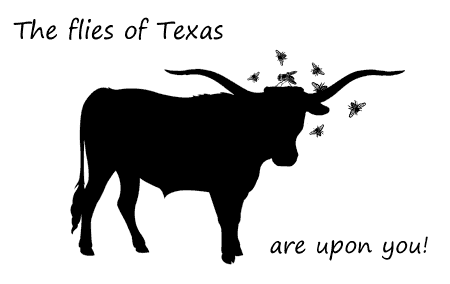
|
In this Issue:
|
Healthcare - Can't Live With It; Can't Live Without It

| Volume 19, Issue 4 | April 21, 2017 |

|
In this Issue:
|
Healthcare - Can't Live With It; Can't Live Without It
I came across an interesting statistic in researching this little essay: without exception, every patient served by the U.S. healthcare system has died. It is good to know we have a perfect record in something.
On the other hand, just about everyone has experienced, or at least knows someone who has, terrific examples of great improvements, and in many cases lifesaving instances, of how healthcare has come through with flying colors. Yes, it costs way too much. Yes, it can be extremely frustrating, even totally absurd. Yes, any particular one of us could likely make it a lot better if only we might be listened to by decision makers and they would come together in constructive, statesmanlike, cooperative ways. Yet, on balance, it is better than if we did not have one.
Nonetheless, the exasperation level is so high...wish I could get every lawmaker in a room by him- or herself, point a gun, and say with absolute truth and conviction, your life depends on this (as, by the way, actually do the lives of many of their constituents): come up with a workable healthcare system for our country, one at least tolerable for 90% of us, one that is more convenient and patient-oriented, costs less than what we have now, provides better care, and results in ours being right at the top of the heap in terms of medical outcomes and life expectancy. You have one month, or you'll be dead. We all know, however, that is not going to happen. If it did, we might lose a large number of Congressmen and Senators. We are for the foreseeable future, and though it is tweaked around the edges, either stuck more or less with what we have or in for an even worse arrangement at some point down the road.
Accepting this then as best I can, I would like to review or pay tribute to a few glass is half-empty and glass is half-full aspects of healthcare as I and others have understood it and benefitted or suffered from it. A little girl who would have been my aunt Wilma died of congestive heart failure at age 5. Her doctors could not save her. My dad was so badly treated after a motorcycle accident that he vowed, and largely stuck with this pledge to himself, for the rest of his life never to see a physician or go into a hospital again. My mother survived a rattlesnake bite, but was nearly killed in the hospital by the care received there for it. I had congestive heart failure as an infant and toddler and suffered symptoms similar to my young aunt's. As it happened, by then x-rays were in their pioneer days of use, so the doctors decided to cure me by giving repeated, massive doses of them in my neck and upper chest. I survived despite their care, and later was told that the treatment would make me more susceptible to cancer in the affected areas. Happily, that has not happened. I do have significant thyroid (neck gland) dysfunction for which medications are required. Dentists have rendered the left side of my mouth in worse shape, so I need to chew anything hard only on the right. Doctors fixed a birth deformity, a partial club-foot difficulty (the soles of my feet turned inward instead of down to the floor or ground), but in doing so left my spine in an odd configuration and my natural stance set with shoes turned outward instead of straight ahead.
A brother of mine had an apparently severe concussion, with confused thinking 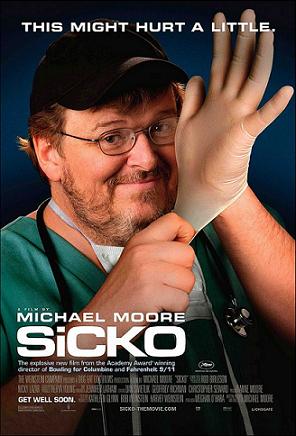 and passing out, yet I understand he was left largely without supervision for long periods once at the hospital.
and passing out, yet I understand he was left largely without supervision for long periods once at the hospital.
During numerous instances from my times as an orderly at Austin State Hospital (in TX) and Herrick Memorial Hospital (in Berkeley, CA) I noticed that patients were badly treated, were neglected for many hours at a time by medical staff, or were allowed to be abused or injured by staff or other patients. Heart patients were sometimes left in the care of people who did not have basic CPR training. Unresponsive schizophrenic patients were left with little or no stimulation for long periods. In one case, an apparently unnecessary lobotomy was performed. In another, a patient was violently hit by another with a broom handle, hard enough to knock the victim down and leave a big knot on his head. His assailant was unrestrained and had been committed there as criminally insane. In yet another, a man just being admitted had an apparent heart attack, was not seen by medical personnel for over half an hour despite emergency calls, and died. Another man had multiple cancerous lesions so large they extended from outside to inside his abdomen. He leaked blood and fecal material more or less perpetually onto his bedding. A woman had a cancerous breast that had not been treated for at least many months, years more likely. A young man in his twenties somehow managed periodically to get hold of and swallow "sharps," needles and razor blades, necessitating new surgery each time to remove the extra hardware and leaving his esophageal passage a mass of scar tissue.
Yet, balancing these harsh circumstances are many positive instances of great benefits from medical care. For instance, another brother as a small child swallowed poisonous chemicals he had discovered under a sink, before anyone realized he had the mobility or inquisitiveness for danger from that hazard. When found, he appeared near death, yet a rush to the hospital resulted in his life being saved. When another of my brothers was not yet born our mother fell down a flight of stairs hitting the concrete basement below. A rush to the hospital allowed her to be OK and that brother to be born healthy. A brother accidentally slashed his thumb badly, nearly amputating it with a machete used for cutting small limbs and brush as fodder for our goats herd. Swift medical attention led to the thumb being saved and now functioning normally. A nephew fell and injured his back badly. It healed incorrectly, leaving him in great pain and unable to do feats that were easy before, yet a surgery corrected the damage and restored him to normal functioning. I have seen severely depressed patients respond so well to treatment they can give up both therapy and medication. Almost miraculous surgery has removed a growth on a niece's pituitary gland. Replacement of my then 92 year old mother's knee occurred so beneficially that she was only weeks later essentially pain free and walking better than in years. Procedures for her cardiac fibrillation condition have also returned her to good health and energy. I have witnessed folks who were almost immobile become strong and able to walk again through medical assistance. I have seen folks with the among the worst kinds of mental diagnosis restored to gainful employment and normal activities of daily living. I have seen how American physicians have risked their lives and gone into war zones where they have helped hundreds or thousands of injured or otherwise dying patients, hurt in regional conflicts, get new leases on life.
There is much left at this point to be desired in our healthcare system, yet, for all the division and dysfunction in Washington, there is still much cause for hope. We are not starting from scratch, and medical service provision is, I am convinced, getting better all the time. It is, to be sure, a mixed bag, and there is much to which we can point with disfavor. However, for all its faults, it permits our average length of years in this world to creep more or less steadily upward, mostly also with good quality of life.
We may wish for much to be improved, and I certainly am one of those who do, but still there are great boons available to us in today's medicine, and maybe we can learn and build on what still ails our system, till it too is clearly on the mend.
By the time I was three years old, I dreamed of the ocean. I'd seen pictures in books of fabulous seashells, colorful crabs, insanely strange fish and weird creatures that didn't even look like animals. With names like Sea Cucumber, Chiton, Tunicate, Brittle Star, Jellyfish and Ctenophore, such oddities were like science fiction realized. These and more could be found, so I understood, by simply walking on the beach to see what had washed up. Like most kids, I had an insatiable appetite for novel discoveries, and just about everything in my short existence fit the bill. But the limited array of mostly brown-colored small animals that lived in rivers and lakes around us just didn't seem as intriguing as the seemingly endless variety found in saltwater.
I grew up in northern Illinois where the only naturally occurring water was fresh, and, before the Clean Water Act of 1972, often quite polluted with chemicals. In spite of the odd smells and glistening sheen of oil, many of the ponds and streams did contain an interesting assortment of aquatic animals. Vertebrates were easy to find, recognize and understand. They were somewhat like us, having a backbone, pair of eyes, tail and such. We kept fish, tadpoles, snakes and turtles as pets. But, early on,
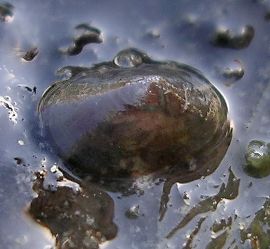 Freshwater Limpet |
My family spent many weekends at the Kankakee and Fox Rivers, Forked Creek, and local ponds, lakes and quarries just outside of Chicago. While my parents were off fishing, I spent a lot of time messing about in the water, using a small net, turning over rocks, and examining aquatic plants for things adhering to them. I would put anything slightly unusual into a jar or bucket and later try to figure out what it was. Probably not so surprising given the popularity of the unusual, it was easier to find books that focused on the exotic saltwater animals of the seashore than on our mundane freshwater fauna. Without internet, a knowledgeable person to ask, or anything more than a Golden Nature Guide called Pond Life at hand, my guesses at identifications were not particularly accurate. But that urge to attach labels to all the animals I saw, which, by the way, is extremely deep-rooted in human evolution, had to be satisfied. So my early understanding of animal taxonomy formed in a haphazard mix of reality, guesswork and flights of fancy.
Our aquariums often held an odd assortment of animals besides fish. I knew the very commonplace creatures, such as crayfish, dragonfly naiads and water mites. Those belonged, respectively, in crustaceans, insects and arachnids. But there were also "worms" which included everything from leeches to horsehair worms to planarians. Basically, anything that was sort of long and slender was lumped into this category. The really tiny animals were also a puzzle. How did daphnia, cyclops, vorticella, and hydras fit in to the overall picture? At least insect larvae were relatively easy to recognize for what they were. After all, it's a cinch to count six legs.
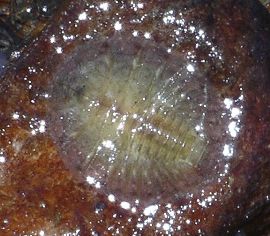 Water Penny (a beetle larva) |
Some of the most delightful curiosities were the freshwater counterparts to more familiar saltwater animals. Even though they look like small lobsters, crayfish were just so common that I did not really appreciate their resemblance. However, the rare freshwater shrimps were far more intriguing. Small and nearly transparent, they were particularly special because they were, well, shrimp, and they looked EXACTLY like the saltwater versions. One creature that I never found, but certainly hoped to one day encounter, was the elusive freshwater jellyfish. I'm still waiting for that one. Freshwater sponges were more appealing in theory than the reality of these small, nondescript rock encrusting animals.
There were plenty of snails and clams in Midwestern streams and lakes. But none of the snails were anything like the porcelain beauties that could be found at the seashore. They were ALL just plain brown. Some of the clams (for some reason called mussels, even though they don't look anything like those edible types found in saltwater), though, had lovely internal pink, purple or blue nacre, often with lovely iridescent rainbow highlights. We even found the occasional pearl.
One kind of snail did pique my interest, and a recent encounter with this was one of the germs of this particular essay.
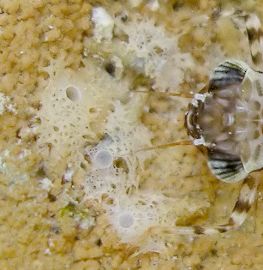 Freshwater Sponge near Damselfly Naiad |
There was one mystery animal that I never figured out until I was an adult. Small, flat, round armored arthropods clung to the submerged rocks along the shores of rivers. The only thing we could think of that looked remotely similar were chitons. There was just one obvious problem with this label, though, and that was the not insignificant detail that chitons are mollusks and these definitely were not. They seemed to be some sort of insect, since they had six legs on the underside. Their grip was tenacious and it was difficult to pry them off to get a good look. When dislodged, they would sort of curl up and seem to be very unhappy. I still think of them as "chitons" even though now I know they are beetle larvae and the official common name is "water penny." Funny, they didn't look like pennies at all when I was a kid, and I still don't think they do.
I mentioned earlier that a recent discovery of limpets in a pond helped spark this short writing. There was another sighting that contributed as well: an easily recognized example of a freshwater sponge. Those that I'd seen as a kid were not particularly impressive, being just sort of shapeless masses attached to sticks and other underwater substrate. This one was not noticed until I looked at a photo I took of a damselfly naiad clinging to the underside of a rock that I had turned over in the clear, fast-flowing water of a local creek here in Texas. Below the damselfly's head was a patch of lighter color sort of smeared over the rock, stretching out in all directions and containing the very well-formed round openings that are characteristic of sponges. I hardly ever saw sponges in the Illinois waters decades ago and, since then, had seen none at all. After so many years, this new find was both a pleasant surprise and a bit nostalgic, reminding me of the wonders that are everywhere around us. All we need to do is pay attention.

On a visit to the Texas coast during Dec., 2016, Isabella, Amie and Lucas just had to pose for a souvenir portrait after enjoying the offerings at a Whataburger in the city where it all started: Corpus Christi. The founder of the company, Harmon Dobson, died 50 years ago this month in a tragic plane crash. His wife, Grace, went on to expand the business over the next couple of decades, and the fast food restaurants continue to be popular in ten southern U.S. states.
![]()
| (The Terra Tabloid is a venue for the discussion of issues pertaining to the past, present, and future of our planet and human interaction with it.) |
At age three, I first became aware of these fly larvae when in Georgetown, an upscale part of Washington, D.C., where my parents and I lived at the time. My folks noted that the contents of a garbage can out back of our townhouse was infested with them. There being no spaces between ours and adjoining living quarters, Dad and Mom tried to hurriedly move the container through our residence to be disposed of out front, but there was no lid, and about halfway across the front room, the whole mess accidentally tipped over and spilled out onto the carpet. Hundreds of little grubs now sought to burrow into the weave of the rug, which led to much disgust and frantic behaviors by my mom and dad, including beating at the now writhing yet disappearing mass with a broom: whack, whack, whack!
A maggot is defined as a soft-bodied, legless, larval form of a fly and often is found in decaying flesh, since adult female house flies and bot flies, for instance, tend to lay their eggs there. Animal flesh is not necessarily required. Rotting veggies, fruit, and wood will do nicely too. In the natural order of things, objectively maggots are no more onerous and disgusting than vultures, both kind of creatures filling a practical niche and purpose, ridding the surface of the Earth of untold trillions of tons of carcasses that would perhaps otherwise accumulate into vast heaps wherever on the planet animals and plants complete their life cycles. Maggots also assure that energy in the form of calories inherent in both our dead tissues and those of all other late fauna and flora still above ground gets efficiently reused.
In the normal course of things, something else eats the flies that came from their maggots, a spider perhaps, something bigger eats that, etc. Eventually, indeed, we may consume a turkey or a fish that ate one of the flies, or something else which ate them, etc. So if we just let nature take its course, sooner or later we would in a manner of speaking be eating ourselves. Were it not so, what a lot of wasted food and energy!
In fact, in this increasingly energy frugal world, it is a shame that we waste the available fuel that is our own bodies, instead converting hydrocarbons to heat and burning our loved ones' mortal remains or filling them with such embalming chemicals that they pollute the very ground from which new growth might otherwise have come, in both cases keeping them from rapidly returning to being the healthy soil from which we ultimately derived, a process of disposition which, left to their own impulses, maggots would, like sharks do in the deep, happily assist us. We had better hope no viruses take out the maggots. We would then have a huge problem with excess dead tissue in the world, as well as the loss of many species that depend on flies for food.
In the movies, though, flies are typically portrayed as both bad and gross. It seems reasonable, then, that, rather than revering the form (as perhaps indirectly was done in "Lord of the Flies") when we come upon a maggot-ridden corpse, the numerous wriggling maggots heaving about just below the surface, each in a frenzy to eat its fill before the available supply is depleted, we may react by heaving too and losing our collective lunches.
Flies, of course, have other beneficial functions, ones we may accept more readily. For example, in ancient and modern times alike, maggots have been used to aid in medicine, quantities being put into wounds so they can cleanly separate the dead and putrid flesh from that which is still living. Maggots can more quickly debride the dead from the living, cleanly removing what can no longer heal from where still connected to living tissue, and with greater precision, than if cruder human instruments are employed to cut away no longer viable muscle and skin.
People usually do not give piles of living maggots more than a passing glance before looking away and maybe uttering a curse or a loud "Yuck!" Yet for the curious there is more here than merely grounds for disgust. Here are a number of less known things about maggots that might be at least interesting, if not exactly whetting our appetites for more:

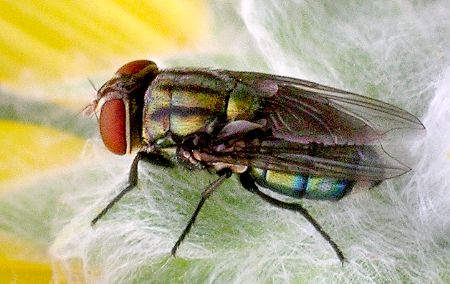
The metallic blue or green flies in the family Calliphoridae are commonly called blow flies. Many are economically important and the secondary screwworm (Cochliomyia macellaria), named for the behavior of its larvae, is one of these. It is found across much of the U.S. and is related to the notorious primary screwworm, which looks very similar but has maggots that feed on living flesh instead of dead. Luckily for animals and people in North America, the primary screwworm was eradicated in an intensive program that began in the 1950s in Florida and included the entire southern U.S. by 1982. Most of Mexico was also targeted and the flies disappeared there by the mid 1980s. Continued efforts into the 1990s expanded the fly-free zone into several Central American countries as well. In spite of a recent outbreak of the primary screwworm in the Florida Keys last year (thought to possibly be caused by insects from Cuba), our country remains free of the pest, though this situation requires constant monitoring.
Although not the devastating livestock pest that its cousin is, the secondary screwworm will sometimes infest wounds where dead tissue is present and can transmit a number of diseases in the process. However, it is also beneficial in several ways. These flies are important decomposers of carrion and their life cycle is well studied, making them useful in forensic investigation. As an added bonus, the adult flies feed on nectar and are pollinators.
a. High Quality: stocks with VL timeliness and safety rank each 1, 2, or 3, financial strength A++, A+, or A, a maximum combined numerical rank of 5 or less (counting A++ as 0, A+ as 1, and A as 2, and adding this value to the latest reported VL timeliness and safety ranks), 4 or 5 Motley Fool CAPS stars, and VL 3-5 year average annual projected total return 15.00% or above; OR
b. Smaller-Cap Dividend: stocks from VL small-cap above average dividend screen with VL timeliness rank 1 or 2, safety rank 1, 2, or 3, financial strength rating B+ or better, a P/E in the range 4-18, a dividend of 2.5% or better, dividend payout ratio 0.60 or below, at least 3 significant value mutual fund holders of the asset's shares, 4 or 5 Motley Fool CAPS stars, and VL 3-5 year average annual projected total return 15.00% or above.
| Company | Ticker Symbol | Recent Price | Dividend |
|---|---|---|---|
| The Buckle, Inc. | BKE | $17.83 | 5.5% |
| Cardinal Health | CAH | $72.31 | 2.2% |
| CVS Health | CVS | $78.22 | 2.5% |
| Infosys, Ltd., ADR | INFY | $14.42 | 2.3% |
| McKesson Corp. | MCK | $137.04 | 0.8% |
| Novo Nordisk, ADR | NVO | $36.17 | 2.2% |
| Qualcomm, Inc. | QCOM | $52.71 | 4.3% |
| Teva Pharmaceutical, ADR | TEVA | $31.05 | 3.6% |
| Verizon Communications | VZ | $49.12 | 4.7% |
Why does it work? By dollar-cost-averaging, purchasing about monthly (each 28 days) an approximately equal amount of the chosen assets, one is spreading the risk over time and also achieving diversification, spreading risk as well among several holdings. All eggs are not in one basket. Risk is reduced too by picking mainly the stocks of financially strong enterprises. Further, dollar-cost-averaging tends to result in more shares being bought when prices are low, fewer when they are relatively high, thus assuring that, on average less is paid for the shares. This buying low tenet is supported as well by selecting among the qualifying candidates the one security (not already owned) at each new investment that has the best risk-adjusted potential. Chosen stocks tend to be those that, though strong companies, are currently lower in price as a result of various temporary market conditions. By selling the weakest holding that no longer meets buy criteria, one upholds another profitable investment tradition: "Sell the losers and let your profits run." On average, the assets will be in the portfolio for several months, allowing most to provide valuable dividend payments, a significant portion of the total return. Ben Graham recommended buying the shares of successful corporations when they were at bargain levels, then selling the majority of them once they had been restored to closer to their true value as providers of a stream of income for shareholders. Others, those that had since share purchase not been good performers because of such contingencies as poor management or dysfunctional business decisions, were also to be weeded out. This method is not as precise as that advocated by the value investing pioneer, but is a good ballpark version of his strategy.
How does one tell which are the best available new assets meeting a set of criteria such as those above? Each investor must research this issue for him- or herself or rely on the services of a trusted financial consultant. My preference is to stick to measures that, as far as possible, are mathematical. Looking at the first set of criteria, for example, suppose I had three candidates that met all of the requirements up to the final selection, XXX, YYY, and ZZZ. Due to copyright concerns, I cannot use actual VL stocks for this illustration; nor can I include VL rankings or financial strength ratings in the table. Yet perhaps XXX has a numerical total of timeliness and safety ranks plus the numerical equivalent of its financial strength (see #3a) of 5 and an average annual projected total return from VL of 18.0 (derived by adding the 3-5 year low and 3-5 year high projections and dividing by 2), while YYY has a numerical total of 4 and an average annual projected total return from VL of 18.0. Since 5 is a riskier numerical total than 4 and the projected total returns are the same, YYY is the better risk-adjusted return choice. But suppose ZZZ has a numerical total of 5 and an average annual projected total return from VL of 25.0. Here, ZZZ proves to be the best pick (if not already in the portfolio). Why? To obtain the risk-adjusted return potential, I would have divided each asset's average annual projected total return by its numerical total. For XXX, this is 18/5 = 3.6. For YYY, it is 18/4 = 4.5. For ZZZ, it is 25/5 = 5.0. Everything else being equal, on a risk-adjusted basis ZZZ would be the best choice.
I am not a professional. In my amateur experience, however, users of this strategy should see significantly above average long-term returns. Had a person been employing this method last year, for instance, he or she would likely have acquired shares of Berkshire Hathaway, Class B shares (BRK/B) and Franklin Resources (BEN) near their lows for the following year and have seen total returns of about 17% (BRK/B) to 25% (BEN). I am not saying this kind of profit is expected, but it is also not atypical. On the other hand, one would also likely have picked up shares of Infosys, Ltd., ADR (INFY), which still meets the first set of criteria, and so is not yet eligible for sale, but has underperformed the market since it met buy requirements several months ago. Once gainers and losers are averaged out, overall long-term performances of 12-13% plus annual average dividends of 2-3% (i.e. total returns of about 14-16% a year) would not be unreasonable before taxes, if one stays invested, sticks to the method through both up and down markets, and reinvests dividends. If in addition we add new investments modestly in excess of the weaker assets' redemptions, combined mean increases in liquid assets of 20% or better would be possible. Not bad.
In my opinion, currently good choices for readers' further analysis are shown in the table. My favorites from that list now are CVS Health (CVS) and McKesson Corp. (MCK).
"Value Line" is available by subscription, the online-only versions lower in price. Often libraries or brokerages also have "Value Line" available. Indeed, this is how my paternal grandfather, Papa Frank, got information for his stocks selections. Papa Frank was a pastor who averaged around $200 a month, as his career spanned the Great Depression. Sometimes folks in the congregation had no money for the donation plate but might pass along a rabbit or a chicken. He became a millionaire by virtue of his bargain stock purchases. At the time, that was regarded as being wealthy.
| |||||||||
|
Although faultless spelling is considered an archaic art, something as simple as a space within a word can make a substantial difference in meaning. Many insects' names have the word "fly" in them, because, well, so many of them CAN fly. There is a distinction, though, between TRUE flies (insects in the order Diptera) and all the other insects, in many different orders, called flies. A true fly has a space in its name between the prefix and "fly," such as House Fly or Blow Fly, while all other kinds of insects have the prefix attached to the suffix: Dragonfly, Caddisfly, and Firefly. Another example of totally different meanings determined by a single space: May Day is a pleasant holiday, while Mayday is a dire situation!
So we hope all our readers have a wonderful May Day, keep Maydays to a minimum, and don't forget Mother's Day as well.
|
| For others who may have chanced upon this site, larvalbug bytes is a monthly family-and-investment newsletter, put out by an old codger and sweet thing, with sometimes a little help as well from our engaging pooch, Peri. We invite readers' comments by and would also be happy to readers when new issues are published. Articles and stories from back issues are available in our archives. |

|
Copyright © 2017 by LARVALBUG
"The Flies of Texas" and larvalbug web design by Valerie.
![]()